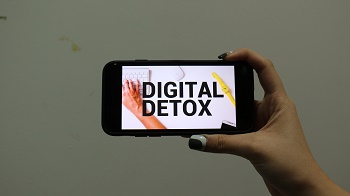
Digital detox, which is also known as digital minimalism, refers to voluntary abstinence one attempts from their digital devices and social media. The movement represents millennials’ sense of desperation to separate themselves from their phone, with #digitaldetox on Instagram or other pledges on limited and controlled device usage gaining popularity.
Internet Addiction Prevention Center (IAPC) which is run by the National Information Society Agency (NIA) is a representative public organization that provides diagnostic tests for smartphone addiction, as well as on and offline counseling services. The center also IAPC runs preventive education for digital device addiction and trains professional phone-addiction therapists and counselors, corresponding to an increased demand for these experts. A simple 10 question survey on IAPC’s website allows children, teenagers, and adults to self-diagnose their smartphone reliance.
The results then categorize people into normal users, potentially risky users and high-risk users according to their ability to control phone usage. The latter two categories are prescribed to diverse forms of digital detox therapies, recommended by the center, including offline counseling and meditation.
However, considering the amount of university education and job-searching that takes place online, putting digital detox into action is not easy for those in need.
Once students enter university, their education takes place online even more than it did during previous years of their education. Universities have their respective portal systems and cyber campuses where professors upload material, post announcements, and require students to upload assignments. Moreover, students preparing certifications for job purposes often purchase ingang, the Korean word for video lectures.
“Not only are all the course-related notices communicated online, but very few of our assignments can be done completely offline,” said Jang Hee-jun, a sophomore in the Division of International Studies.
She went on to point out that group work or team assignments often require the frequent usage of KakaoTalk, the main instant messaging application used in Korea, in addition to actual offline meetings.
During the semester, many students claimed that digital detox was not an option, as they felt that “always being on ready mode” was crucial for school-work, group-work and other club activities.
The continued need for phone and social media usage does not stop at education and in fact extends to post-graduation phases, including career-searching.
Many students who are preparing to enter the workforce or even apply to graduate schools take part in “supporters” programs. These programs comprise of promotional activities, whereby students are required to reveal whether they have social media accounts and how many followers or friends they have, at the time of application.
The logic is that the more friends or followers one has on Instagram of Facebook, the more effective of a promotional agent they will be for private companies or public agencies which select college students based on their social media presence.
“I am disgusted, worried, and annoyed by the reality that I am judged based on the number of virtual friends and connections I have rather than for relevant capabilities I have as a potential employee of a firm,” said an anonymous observer in Department of Business Administration.
Digital hobby in intersection with new technology and other cultural experiences
Associated with the improvement of technology, multi-dimensional experience via digital media is expected to increase. In case of journalism, newspaper firms are on competitive movement in increasing digital subscribers as Mark Thompson of New York Times has also announced in World News Media Congress last June their aim to increase online subscribers to 10,000,000 by 2025. Via virtual reality (VR) and artificial reality(AR), door to new experiences opened as well and is growing as the investments upon the field among Asia and the Pacific area has increased by 100 percent point.
“Digital Generation, Culture and Identity” explains why young people are dependent of digital culture
Current 20s are labeled millennial. This generation covers people born between the mid-1990s and early 2000s. Professor Lee Jong-Im from Sookmyung Women’s University explained in her book “Digital Generation, Culture and Identity” that keys to these generations' digital culture dependency can be attributed to their group characteristics.
Millennials are “digital natives,” people born in times digital devices were already prevalent. Additionally, the professor explains, that this generation has weak bond to their upper cohort. Furthermore, being young, they have yet confined occupation to express their variety within the mainstream. Lastly, she analyzes millennial are prone to discouragement due to exposure to constant breakdown of economy and downfall of employment rate.
Overall, accumulated stress and lack of bond with the upper generation drive young generation to desire to avert to digital space.

